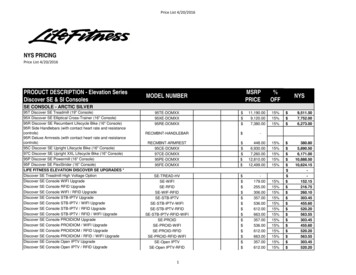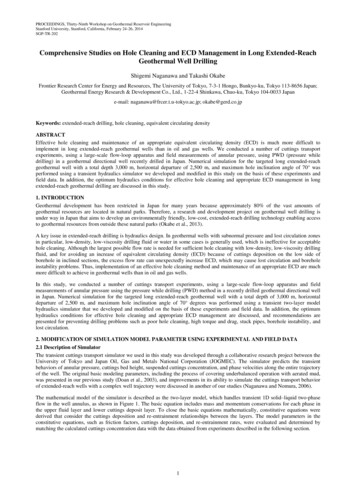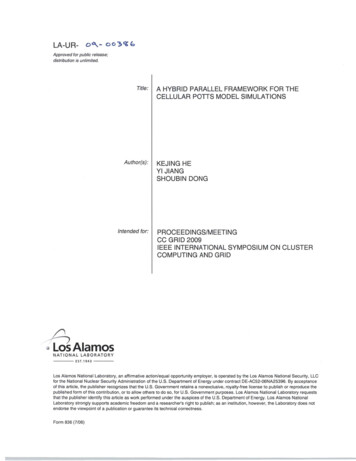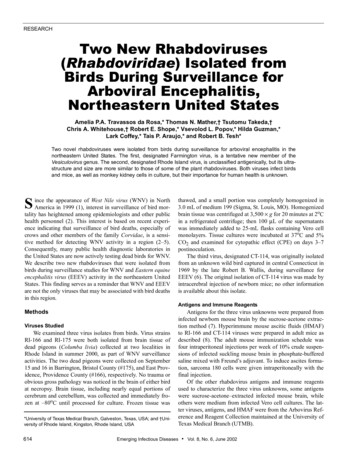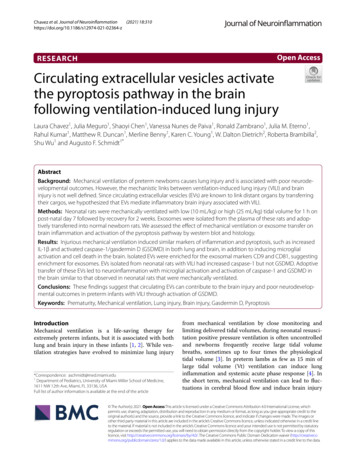
Transcription
(2021) 18:310Chavez et al. Journal of 1-02364-zOpen AccessRESEARCHCirculating extracellular vesicles activatethe pyroptosis pathway in the brainfollowing ventilation‑induced lung injuryLaura Chavez1, Julia Meguro1, Shaoyi Chen1, Vanessa Nunes de Paiva1, Ronald Zambrano1, Julia M. Eterno1,Rahul Kumar1, Matthew R. Duncan1, Merline Benny1, Karen C. Young1, W. Dalton Dietrich2, Roberta Brambilla2,Shu Wu1 and Augusto F. Schmidt1*AbstractBackground: Mechanical ventilation of preterm newborns causes lung injury and is associated with poor neurodevelopmental outcomes. However, the mechanistic links between ventilation-induced lung injury (VILI) and braininjury is not well defined. Since circulating extracellular vesicles (EVs) are known to link distant organs by transferringtheir cargos, we hypothesized that EVs mediate inflammatory brain injury associated with VILI.Methods: Neonatal rats were mechanically ventilated with low (10 mL/kg) or high (25 mL/kg) tidal volume for 1 h onpost-natal day 7 followed by recovery for 2 weeks. Exosomes were isolated from the plasma of these rats and adoptively transferred into normal newborn rats. We assessed the effect of mechanical ventilation or exosome transfer onbrain inflammation and activation of the pyroptosis pathway by western blot and histology.Results: Injurious mechanical ventilation induced similar markers of inflammation and pyroptosis, such as increasedIL-1β and activated caspase-1/gasdermin D (GSDMD) in both lung and brain, in addition to inducing microglialactivation and cell death in the brain. Isolated EVs were enriched for the exosomal markers CD9 and CD81, suggestingenrichment for exosomes. EVs isolated from neonatal rats with VILI had increased caspase-1 but not GSDMD. Adoptivetransfer of these EVs led to neuroinflammation with microglial activation and activation of caspase-1 and GSDMD inthe brain similar to that observed in neonatal rats that were mechanically ventilated.Conclusions: These findings suggest that circulating EVs can contribute to the brain injury and poor neurodevelopmental outcomes in preterm infants with VILI through activation of GSDMD.Keywords: Prematurity, Mechanical ventilation, Lung injury, Brain injury, Gasdermin D, PyroptosisIntroductionMechanical ventilation is a life-saving therapy forextremely preterm infants, but it is associated with bothlung and brain injury in these infants [1, 2]. While ventilation strategies have evolved to minimize lung injury*Correspondence: aschmidt@med.miami.edu1Department of Pediatrics, University of Miami Miller School of Medicine,1611 NW 12th Ave, Miami, FL 33136, USAFull list of author information is available at the end of the articlefrom mechanical ventilation by close monitoring andlimiting delivered tidal volumes, during neonatal resuscitation positive pressure ventilation is often uncontrolledand newborns frequently receive large tidal volumebreaths, sometimes up to four times the physiologicaltidal volume [3]. In preterm lambs as few as 15 min oflarge tidal volume (Vt) ventilation can induce lunginflammation and systemic acute phase response [4]. Inthe short term, mechanical ventilation can lead to fluctuations in cerebral blood flow and induce brain injury The Author(s) 2021. Open Access This article is licensed under a Creative Commons Attribution 4.0 International License, whichpermits use, sharing, adaptation, distribution and reproduction in any medium or format, as long as you give appropriate credit to theoriginal author(s) and the source, provide a link to the Creative Commons licence, and indicate if changes were made. The images orother third party material in this article are included in the article’s Creative Commons licence, unless indicated otherwise in a credit lineto the material. If material is not included in the article’s Creative Commons licence and your intended use is not permitted by statutoryregulation or exceeds the permitted use, you will need to obtain permission directly from the copyright holder. To view a copy of thislicence, visit http:// creat iveco mmons. org/ licen ses/ by/4. 0/. The Creative Commons Public Domain Dedication waiver (http:// creat iveco mmons. org/ publi cdoma in/ zero/1. 0/) applies to the data made available in this article, unless otherwise stated in a credit line to the data.
Chavez et al. Journal of Neuroinflammation(2021) 18:310and inflammation acutely [5, 6]. In the long term, use ofmechanical ventilation is an important contributor to thedevelopment of bronchopulmonary dysplasia, which byitself is an independent risk factor for neurodevelopmental impairment in preterm infants [7, 8]. However, a linkbetween ventilation-induced lung injury (VILI) and braininjury has not been established.Extracellular vesicles (EVs) are involved in intercellular and interorgan communication in diverse physiological and pathological processes including inflammatorystates [9, 10]. EVs carry cytokines, caspases, and miRNAs that can signal inflammation in the target cell [11].In traumatic brain injury, EVs have been shown to contain inflammasome proteins, whose activation can leadto acute lung injury [12]. More recently, we have shownthat circulating EVs from newborn rats exposed to hyperoxia contain inflammasome proteins that can inducelung and brain inflammation when transfected into normal animals [13]. These exosomes also contained gasdermin D (GSDMD)—a molecule downstream fromcaspase-1—that is the effector of pyroptosis. The procaspase-1 protein (30–48 kDa) is cleaved upon activationof the inflammasome pathway releasing a 20 kDa activefragment, this active fragment is responsible for cleavageof pro-IL-1β releasing IL-1β, and cleavage of the 53 kDaGSMD releasing the active 30 kDa fragment that can oligomerize and form the pyroptotic pore in the cell membrane [14].Based on these observations, we hypothesized thatVILI could cause the release of EVs containing pyroptosis mediators into the systemic circulation and that theseEVs could cross the blood brain barrier to induce inflammation and pyroptosis in the brain.MethodsAnimal model of neonatal mechanical ventilationAnimal experiments were approved by the InstitutionalAnimal Care and Use Committee at the University ofMiami Miller School of Medicine (19-011). PregnantSprague–Dawley rats were purchased from Charles RiverLaboratories (Wilmington, MA, USA). Each pregnantanimal was housed in a single cage with water and foodad libitum under 12 h night and day cycles under controlled temperature and humidity. Newborn Sprague–Dawley rats on postnatal day (P) 7 were anesthetizedwith a mixture of Ketamine and Xylazine (80 mg/kgand 10 mg/kg, respectively) by intraperitoneal injection,orally intubated with a 22G intravenous catheter, connected to a small animal mechanical ventilator (MiniVent, Harvard Apparatus, Cambridge, MA, USA) andventilated for 30–60 min with tidal volume of 10 mL/kg (low Vt) or 25 mL/kg (high Vt). The respiratory ratewas set to 150 in the low Vt group and 80 in the high VtPage 2 of 11group to maintain a similar minute ventilation betweenthe ventilated groups. During mechanical ventilation, theanimal was continuously monitored for heart rate, respiratory rate, oxygen saturation, and body temperature witha small animal monitoring station (Harvard Apparatus,Cambridge, MA, USA). Animals received blended supplemental oxygen as needed to maintain blood oxygensaturation above 85%. Control animals were not ventilated. At the end of ventilation, we progressively weanedthe ventilator settings to allow return of spontaneous respirations and then rats were returned to the nursing damfor growth under normal conditions. On P21 (2 weeksafter mechanical ventilation), rats were euthanized andplasma, lung, and brain tissue were sampled.AntibodiesAntibodies information and dilutions used for differentassays are shown in Additional file 1: Tables S1 and S2.The anti-caspase-1 and anti-GSDMD antibodies detectboth the full protein and the cleaved active fragment,which can be discerned in Western blot by the differences in molecular weight.Histological analysisLungs were inflation-fixed with 4% paraformaldehydeat 20 cmH2O via a tracheal cannula for 5 min and thenfixed overnight. Following fixation samples were embedded in paraffin, and sectioned. Hematoxylin/eosin staining was performed and the mean linear intercept (MLI)was calculated as previously described [15]. Brain werefixed in 4% paraformaldehyde without perfusion. Coronal section of 10 µm were obtained and sections fromsimilar areas were selected for staining based on the position and visible structures on adjacent section stained forhematoxylin–eosin.For immunohistochemical staining, paraffin embedded brain sections of 10 µm were deparaffinized andrehydrated before heat-assisted antigen retrieval in citric acid buffer at pH 6.0. Endogenous peroxidase activity was blocked with CH3OH/H2O2 treatment andnon-specific binding sites were blocked with 4% BSA inPBS. Sections were incubated overnight at 4 C with theprimary antibody diluted in 4% BSA in PBS. Sectionswere then washed and incubated with the appropriatespecies-specific secondary antibody diluted 1:200 in 4%BSA for 2 h at room temperature. After further washing, antigen:antibody complexes were visualized using aVectastain ABC peroxidase kit (Vector Laboratories Inc.,Burlingame, CA, USA). Antigen detection was enhancedwith 3,3′-diaminobenzidine tetrahydrochloride. Slideswere then counterstained with Harris hematoxylin.Analysis of immunohistochemical section for IBA-1were counted by 2 independent researchers blinded to
Chavez et al. Journal of Neuroinflammation(2021) 18:310group assignment. Qualitative analysis of the positivecells was performed by these investigators based on sizeof the soma and branching complexity.To investigate the presence of cell death we performedterminal deoxynucleotidyl transferase-mediated deoxyuridine triphosphate nick end labeling (TUNEL) assayswith a commercial kit according to the manufacturer’sinstructions (Click-iT TUNEL Assay, ThermoFisher,Waltham, MA, USA).EV isolation, characterization, and adoptive transferEVs from an equal volume of plasma from control andventilated rats were isolated 2 weeks after mechanical ventilation using the Total Exosome Isolation Kit(ThermoFisher, Waltham, MA, USA) per manufacturer’sinstructions. In brief the reagent was added to plasmasamples and incubated for 30 min at 4 ºC followed by centrifugation at 10,000 g for 5 min at room temperature.The pellets were re-suspended in PBS for downstreamanalyses. Plasma samples did not undergo sonication ortreatment with protease/phosphatase inhibitors. A volume of 4 µL from each EV sample was analyzed for particle number and size distribution by nanoparticle trackinganalysis using the Nanosight NS300 system (MalvernInstruments, Malvern, UK) [12]. EV tagging for imaging experiments was performed using the ExoGlow-VivoEV Labeling Kit (Systems Biosciences, Palo Alto, CA,USA) followed by in vivo whole body imaging using theIn Vivo Imaging System (IVIS, PerkinElmer, Hopkinton,MA, USA), followed by dissection and ex vivo imagingin the same system. Adoptive transfer of exosomes wasperformed in normal rats on P8 and P14 via tail veininjection of a protein-based dose of EVs of 50 µg per doseanimal.Western blot analysesProtein concentrations of tissue homogenates or EVswere measured by BCA protein assay using a commercialkit (Pierce Biotechnology Inc., Rockford, IL, USA). Totalproteins (20 µg/sample) were fractionated by SDS-PAGEon 4–12% Tris–glycine precast gradient gels (ThermoFisher, Waltham, MA, USA) and then transferred tonitrocellulose membranes (Amersham, Piscataway, NJ,USA). The membranes were incubated overnight at 4 Cwith the respective primary antibodies and then incubated for 1 h at room temperature with HRP-conjugatedsecondary antibodies. Antibody bound proteins weredetected using ECL chemiluminescence methodology(Amersham, Piscataway, NJ, USA). The intensities of protein bands were quantified by ImageJ [16]. Band densitywas then corrected for beta-actin band density in thesame lane. Values were then divided for the average control value to represent fold change relative to control.Page 3 of 11Cytokine/chemokine assayRat cytokine/chemokine concentrations in plasma, lunghomogenates, and corpus callosum homogenates wasdetermined by rat cytokine array/chemokines array-27(Eve Technologies, Calgary, Canada). Blood was obtainedby cardiac puncture at the time of euthanasia, placed onheparin tubes and vortexed for plasma extraction. Flashfrozen lung and brain tissue were homogenized in RIPAbuffer (Santa Cruz Biotechnology, catalog # sc-24948)and centrifuged at 12,000 rpm for 20 min at 4 ºC. Thesupernatant was transferred to a new tube and protein concentration was measured by BCA protein assay(Thermo Scientific, catalog # 23228 and 1859078). Samples were than diluted for a target protein concentrationof 3–4 mg/mL. Values for samples with signal outsidethe curve were calculated when feasible by the model.Lower limit of detection for plasma and tissue samplesare shown in Additional file 1: Table S3.Data analysisStatistical analyses was performed using GraphPad Prismwith ANOVA for parametric or Kruskal–Wallis for nonparametric test performed on each outcome relatedto GSDMD, caspase 1 expression, brain inflammatorymarkers, and cellular death. Decision for use of parametric or nonparametric test was based both on normalityand lognormality distribution using the Shapiro–Wilktest as well as based on visual analysis for data distribution, outliers, and prior experience with the experimentsin this model. Specific tests used for each analyses aredescribed in the results. For ventilation-induced lungand brain injury experiments a total of 10 animals werecreated per group. For the analysis of lung structure andMLI we excluded the animals that had inconsistent inflation fixation which would bias the results. Animals usedin the MLI analysis were given preference for downstream analyses, including exosome analyses and adoption transfer experiments. For the TUNEL assays dueto low number of TUNEL positive cells present in thebrain tissue overall across all groups all 10 animal wereincluded in the analysis.ResultsVILI activates caspase‑1/GSDMD in the lungTo understand the role of VILI on neonatal brain inflammation and injury we ventilated newborn rats on postnatal days 7 with low (10 mL/kg) or high Vt (25 mL/kg) for 1h. After ventilation, animals were extubated and returnedto the nursing dam. Animal data are shown in Table 1.To verify that our model caused ventilation-inducedlung injury we assessed lung alveolarization in histological lung sections by measuring the MLI. Neonatal rats
Chavez et al. Journal of Neuroinflammation(2021) 18:310Page 4 of 11Table 1 Animal dataControlLow VtHigh VtEV-injectedControl EVLow Vt EVHigh Vt EVn101010555Age at ventilationP7P7P7n/an/an/aAge at EV injection #1/#2n/an/an/aP8/P14P8/P14P8/P14Age at samplingP21P21P21P21P21P21Weight (g)70 4.871 6.870 8.874 3.777 3.7Sex (M/F)5/55/5ventilated with high tidal volume had increased MLIcompared to unventilated animals showing alveolar simplification at 2 week post-ventilation (Fig. 1A–D). Wethen assessed whether ventilation induced lung injuryalso induced the expression and activation of caspase-1and GSDMD in the lung. High Vt mechanical ventilation increased total and active caspase-1 (Fig. 1E) andGSDMD at 2 weeks (Fig. 1F) after mechanical ventilation,suggesting activation of pyroptosis in VILI.VILI causes brain inflammation and cell deathWe then assessed the effects of VILI on brain inflammation through microglial activation by IBA-1 immunostaining in the brain of controls and ventilated rats2 weeks after mechanical ventilation. Rats ventilatedwith low or high Vt in the neonatal period showed anincreased number of microglia in the corpus callosumcompared to controls (Fig. 2A–D). The microglia in the6/43/22/373 3.52/3animals with VILI also showed a more active phenotypewith larger soma and thicker ramifications. This microglial activation was associated with increased cell deathin the white matter of rats ventilation with high tidal volume, as identified by TUNEL assay (Fig. 2E–H), suggesting neonatal VILI leads to microglial activation and celldeath in the corpus callosum and subcortical white matter (Fig. 2E–H).To determine whether lung derived cytokines fromVILI animals could be contributing to the continued microglial activation and cell death in the brainat 2 weeks after mechanical ventilation, we measuredcytokine and chemokine concentrations in the lung,plasma, and corpus callosum by multiplex assay (Fig. 3).Interestingly, IL-1β was increased in the lung and corpus callosum, but not in the plasma of animals ventilatedwith high Vt (Fig. 3). Other cytokines assessed showed nodifference among groups (Additional file 1: Table S3).Fig. 1 VILI causes alveolar simplification and activates caspase-1 and GSDMD in the neonatal lung. A–D Photomicrographs (20 ; bars 50 µm)of H&E-stained lung sections from rats on P21 of representative control animals (A) and rats mechanically ventilated with low (B) or high Vt (C)showing alveolar simplification and increased mean linear intercept (D) in animals exposed to high Vt mechanical ventilation. N 6 controls, 5low Vt, and 6 High Vt. E–F Western blots showing increased active caspase-1 (p20 fragment) (E) and active GSDMD (p30 fragment) (F) in lunghomogenates 2 weeks after injurious mechanical ventilation with high Vt. N 4 controls, 4 low Vt, and 4 High Vt. Data are presented as box plotsshowing the median, 25th to 75th percentile, and minimal to maximal value normalized to control. Data was analyzed by ANOVA with Dunnett’spost-test, p values 0.05 are shown on bars
Chavez et al. Journal of Neuroinflammation(2021) 18:310Page 5 of 11Fig. 2 Injurious mechanical ventilation causes brain inflammation and cell death. A–D Microglia count and activation. Photomicrographs (20 ;bars 50 µm) of representative brain section immunostained for the microglial marker IBA-1 showing the corpus callosum from controls (A), lowVt (B), and high Vt (C) animals. There was microglial count (D) and morphological changes of the microglia consistent with microglial activation(inserts) with increased soma and thickened ramifications in ventilated animals. N 5 animals/group. E–H TUNEL assay for assessment of cellulardeath. Photomicrographs of fluorescent stained brain sections for TUNEL assay of the corpus callosum from controls (E), low Vt (F), and high Vt (G)animals. There was an increased proportion of TUNEL cells in animals ventilated with high Vt (H). N 10 animals per group. Data are presentedas box plots showing the median, 25th to 75th percentile, and minimal to maximal value. Data was analyzed by ANOVA with Dunnett’s post-test, pvalues 0.05 are shown on bars. Hpf high-power fieldFig. 3 VILI increases IL-1β in the lung and corpus callosum but not in the plasma at 2 week post injury. Multiplex ELISA shows increased IL-1β in thelung (A) and in the corpus callosum (C), but not in the plasma (B) of animals with VILI. N 6 controls, 4 low Vt, and 5 high Vt. Data are presented asbox plots showing the median, 25th to 75th percentile, and minimal to maximal value. Data was analyzed with the nonparametric Kruskal–Wallistest with Dunn’s post-test for multiple comparison, p values 0.05 are shown on barsAs caspase-1 cleaves both pro-IL-1β and proGSDMD, we assessed the expression and activation ofthese proteins in the brain after mechanical ventilation(Fig. 4). High Vt induced activation of GSDMD (Fig. 4B)but not caspase-1 (Fig. 4A) in the brain. The increasedexpression of GSDMD localized to the corpus callosumand subcortical white matter by immunohistochemistry (Figs. 4C–E), suggesting that VILI induces GSDMDexpression and activation in the neonatal white matter.Mechanical ventilation increases caspase‑1 in circulatingEVsWe hypothesized that circulating EVs could be mediatingthe lung–brain inflammation communication in rats withVILI. EVs were isolated from the plasma of controls andventilated animals and analyzed by nanoparticle tracking(Nanosight), which revealed various particle size peaksranging from 8 to 453 nm with a distinct exosome-sizedparticle peak at 90–120 nm, containing the majority of
Chavez et al. Journal of Neuroinflammation(2021) 18:310Page 6 of 11Fig. 4 Injurious mechanical ventilation activated the pyroptosis effector GSDMD. A, B Western blot of the neonatal rat brain for caspase-1 (A) andGSDMD (B) showing increased relative band intensity of the active GSDMD fragment in whole brain homogenates from animals ventilated withhigh Vt. N 4 animals/group (caspase-1) and N 10 animals/group (GSDMD). Data was analyzed by ANOVA with Dunnett’s post-test, p values 0.05are shown on bars. Data are presented as box plots showing the median, 25th to 75th percentile, and minimal to maximal value normalized tocontrol. C–E Photomicrographs (20 ; bars 50 µm) of representative brain sections immunostained for the GSDMD showing the corpus callosumand subcortical white matter in controls (C), low Vt (D), and high Vt (E) animals. There was increased staining for GSDMD in the corpus callosum andsubcortical white matter of animals ventilated with high Vt. N 4 animals/group. Data was analyzed by ANOVA with Dunnett’s post-test for multiplecomparison, p values 0.05 are shown on barsthe EVs (Fig. 5A–C). Western blot for the exosome markers CD9 and CD81 also showed that isolated circulating EVs contained high levels of these markers (Fig. 5D).Given their size and lipid membranes, EVs have the ability to easily cross tissue barriers. To assess if the EVsisolated from the plasma could cross the blood brainbarrier, they were tagged with the ExoGlow system andadoptively transferred via tail vein injection into normalnewborn rats on P7 (Fig. 5E). In vivo imaging at 1 and4 h showed that the EVs distributed through the body,including chest and head. At 4 h, these newborn ratswere euthanized and their brains dissected. Ex vivo imaging showed the presence of the tagged EVs in the brainof these animals, proving that adoptively transferred EVscan cross the blood–brain barrier.We hypothesized that the circulating EVs from animals with VILI would contain increased caspase-1 andGSDMD as we had observed in the lung. Western blot ofthese EVs for caspase-1 and GSDMD showed that the circulating EVs from rats with VILI had increased caspase-1(Fig. 5E) but not increased GSDMD (Fig. 5F) comparedto controls, suggesting that caspase-1 is selectively loadedinto the EVs from ventilation-injured lungs.Adoptively transferred EVs can activate GSDMDin the brainTo assess if circulating EVs from animals with VILI couldactivate GSDMD and induce cell death in the brain, weperformed adoptive transfer of isolated EVs from controls, low Vt, and high Vt ventilated animals into normal newborn rats via tail vein injection on P7. We foundthat 2 weeks after adoptive transfer, EVs from animalswith VILI caused neuroinflammation with increasedmicroglial count in the corpus callosum (Fig. 6A–D) andincreased expression of both active caspase-1 (Fig. 6E)and active GSDMD (Fig. 6F) in the brain. While there
Chavez et al. Journal of Neuroinflammation(2021) 18:310Page 7 of 11Fig. 5 Circulating EVs from newborn rats with VILI are selectively loaded with caspase-1 and can cross the blood brain barrier. Nanoparticletracking analysis of EVs isolated from controls (A), low Vt (B), and high Vt (C) show a distinct peak between around 100–120 nm, which correspondsto the exosome particle size. These EVs were enriched for the exosome markers CD9 and CD81 (D). Adoptive transfer by tail vein injection offluorescence-labeled EVs shows that these EVs can cross the blood brain barrier and localize to the brain on in vivo and ex vivo imaging (E). Westernblot of EVs extracted from controls and ventilated animals shows increased activated caspase-1 (F) but not GSDMD (G) in the EVs from animalswith ventilation induced lung injury. Data are presented as box plots showing the median, 25th to 75th percentile, and minimal to maximal valuenormalized to control. N 4 animals/group for nanoparticle tracking analysis. N 10 controls, 6 low Vt, and 8 high Vt for EV Western blot analysis.Data was analyzed by ANOVA with Dunnett’s post-test for multiple comparison, p values 0.05 are shown on bars
Chavez et al. Journal of Neuroinflammation(2021) 18:310Page 8 of 11Fig. 6 Adoptive transfer of circulating EVs from animals with ventilation-induced lung causes brain inflammation. IBA1 staining on brain sectionsof the corpus callosum and subcortical white matter of normal newborn rats who received adoptive transfer of circulating EVs from controls (A),low Vt (B), and high Vt (C) shows increased microglial count with exosomes from animals with VILI (D). Circulating EVs from animals with VILI alsoactivated caspase-1 (E) and GSDMD (F) in the brain compared to exosomes from control animals. N 5 controls, 5 low Vt, and 4 high Vt for IBA1immunostaining. N 3/group for caspase-1 and GSDMD western blot. Data is shown as box plots or individual data points. Western blot data isnormalized to control. Data was analyzed by ANOVA with Dunnett’s post-test for multiple comparison, p values 0.05 are shown on barswas an increase in GSDMD, there was no difference inthe number of TUNEL positive cells (data not shown),suggesting that the inflammation and activation ofGSDMD were not sufficient to induce pyroptosis.DiscussionThe majority of extreme preterm newborns will requirepositive pressure ventilation for survival [17, 18]. Giventhe structural and biochemical immaturity of their lungsthey are susceptible to VILI even after short periods ofinadvertent high tidal volume delivery during neonatalresuscitation [19]. Lung injury from mechanical ventilation contributes to the development of bronchopulmonary dysplasia [20, 21]. Clinically, mechanical ventilationand bronchopulmonary dysplasia are associated with anincreased risk of white matter injury and poor neurodevelopmental outcomes [1, 22], while a more restricteduse of mechanical ventilation in preterm newborns isassociated with improved neurodevelopmental outcomes[23]. With the increasing survival of periviable pretermnewborns with more immature lungs, the use of mechanical ventilation will continue to be necessary in the management of preterm infants [24, 25]. Thus, understandingthe relationship between VILI and brain injury is criticalif we are to prevent brain injury and neurological impairments in preterm infants. Here, we report that circulatingextracellular vesicles from newborn rats with ventilationinduced lung injury can cause inflammation and activation of pyroptosis mediators in the white matter whentransferred into normal newborn rats. Our findings suggest a new injury signaling pathway in preterm newbornswith lung injury.While clinical studies speculate of a causal relationship between mechanical ventilation and brain injury[2], large animal models have provided insight into acausal relationship between mechanical ventilation andlung inflammation and injury [5]. In mechanically ventilated preterm lambs, mechanical ventilation is associated with acute microglial activation, oxidative stress,and caspase-mediated cell death [26–28]. RNA-seq frompreterm lambs subjected to injurious mechanical ventilation for 15 min followed by 6 h of mechanical ventilationshowed activation of inflammatory pathways, including IL-1β signaling and regulation of apoptosis pathways[29]. We have found an increase in IL-1β concentrationin the corpus callosum, as well as microglial activationand increased cell death in the brain of animals with VILIcompared to unventilated animals. In animals ventilatedwith a normal tidal volume we observed a non-significanttrend of increased microglia but with similar IL-1β andapoptosis compared to unventilated animals suggesting there may be more subtle effects even with carefulmechanical ventilation.Circulating cytokines released from the injured lungare potential mediators of brain injury associated withmechanical ventilation. Two hours after initiation ofmechanical ventilation there is an increased plasmaconcentrations of IL-1β, TNF-α, IL-8, IL-10, and IL-6
Chavez et al. Journal of Neuroinflammation(2021) 18:310in preterm infants [30]. In addition, chronic mechanical ventilation for 14 days compared to less than 7 daysis associated with even greater elevation of similarcytokines in the plasma [31]. Moreover, it is not clearhow long the cytokine profile of infants with lung injuryfrom mechanical ventilation remain elevated after positive pressure ventilation has been terminated. We foundincreased IL-1β in the lung and corpus callosum, butnot in the plasma, suggesting that IL-1β is being endogenously produced in these organs. IL-1β is produced uponcleavage of the pro-IL-1 by caspase-1 [32]. Caspase-1also cleaves GSDMD leading to cell membrane pore formation and pyroptosis [33]. We found increased activation of caspase-1 in the lung but not in brain of animalswith ventilation-induced lung injury, while there wasincreased IL-1β and activated GSDMD both in the lungsand brain of these animals, with increased cell deathassessed by TUNEL assay, suggesting activation of thepyroptosis in the brain after injurious mechanical ventilation. We hypothesized that EVs could be transportingcaspase-1 from the injured lung into the brain, triggeringinflammation and pyroptosis.EVs have been implicated in physiological and pathological communication between cells inside the sameorgan and between distant organs [9, 13]. EVs can be classified according to their size, production mechanisms,and contents [34]. Although the plasma EVs isolated inour study were enriched for exosome markers and hadn
Circulating extracellular vesicles activate the pyroptosis pathway in the brain following ventilation-induced lung injury Laura Chavez1, Julia Meguro1, Shaoyi Chen1, Vanessa Nunes de Paiva1, Ronald Zambrano1, Julia M. Eterno1, Rahul Kumar1, Matthew R. Duncan1, Merline Benny1,

